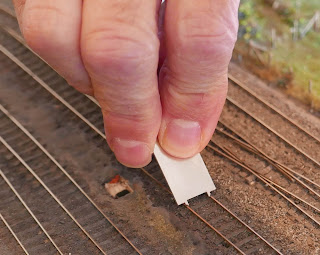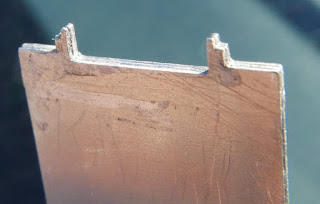The layout and its support structure are stored on the west and east coasts of Scotland respectively, and the legs had been altered since last time we erected the layout, so this was a chance to check that the support was adequate and could be quickly erected.
The support is in two parts and is based on Dexion angle rescued by Andy from a skip, with wooden legs which fold more or less flush for transit. In fact there are two sets of legs, a shorter set for working on the layout and a longer set for shows. Today the shorter set was in place. Bolts with wing nuts are used to hold everything up. First the legs were swung out and secured on the two sections:
Next they were bolted together (the Dexion makes it easy to shorten or lengthen the platform as required):
With the support ready, the fiddle yards were brought out - they are now stored for transit with their modesty boards bolted in place - and the two parts separated:
and finally the scenic section was placed between them:
So far so good, and we moved on to discuss progress with personal projects.
Jim, as usual, has not been idle in the past month, and had a couple of interesting new etches for us to look at. One is a track cleaner etch imitating his hand-filed version, developed as a result of a discussion on RMWeb:
The tool is designed to burnish the track rather than abrade it, so it does not really wear much in use, nor is the track damaged. On the other hand, it is very good at removing gobs of glue or ballast which has stuck to the rail side ... and it can be used through crossings without removing the paint from check and wing rail surfaces. A handy little thing.
Another novelty was a new version of his signal wire pulley stakes, this time designed so that mere mortals might have a chance of assembling it. The etch is designed as two halves which fold over into alignment, to be sweated together.
Simon has been progressing with his LNER 10T fish van fleet, from Foxhunter body kits, and had brought the proof to show us.
He had made a nifty tool to thin the van roofs to something nearer to scale: a piece of wooden dowel of roughly the right diameter with wet-and-dry paper secured to it, to make a large round sanding stick:
All this description of modelling activity was quite stressful for the Edinburgh contingent, so we stopped for a spot of lunch in the sunshine.
Once we had polished off the ham sandwiches and hot soup (in spite of the sun and 20-degree heat, pullovers and jackets were sported: warm days are treated with suspicion north of the Border), we were joined by Mick Simpson, who had wangled an afternoon off from grandparenting, and we went back indoors for the Short Talk. This time we were to hear about scenic techniques for grass, trees and bushes, from Jim who is in the process of working up the scenery on Kirkallanmuir (which, as a reminder, is his home layout based on a Clydesdale mining village set in Caledonian days).
Jim has formed the scenic areas of the layout from a shell of expanded polystyrene profile blocks at intervals, covered with strips of newspaper and a mush of chopped-up cardboard egg-boxes, covered with a base layer of green paint. Grass is added using the often-described static applicator technique - it was nonetheless instructive to see it demonstrated.
The area to be grassed is masked off with pages from the Lanark Gazette:
Next, a quick squirt of cheap sticky hairspray is applied to the masked area:
and the sieve is gently shaken to distribute the fibres. It takes a minute or two to shake even a small amount of fibres onto the layout, and they need to be applied quite densely.
Jim follows the initial 2mm fibre application with 1mm fibres, and also varies the colours, finishing with "patchy dead grass". An internet search (or a browse of the scenic stalls at shows) will reveal plenty of suppliers and colour choices.
Next Jim moved on to discuss trees. In his garden can be found a few Sedum plants, commonly known as stonecrop.
then the flowers can be detached, leaving thin twigs which form the basis for model trees. On their own, the heads may be a little sparse, so extra "branches" can be inserted by carefully slitting a twig with a scalpel and opening out slightly with a small screwdriver before splicing in another twig, fixing it with white PVA. If the lower trunk is not thick enough, fine wire can be added to bulk it out.
The bare structure can now be planted on the layout in holes made by a screwdriver or piece of stiff wire. It's better to plan ahead to build woodland areas entirely from expanded-polystyrene blocks since this holds the tree in place much better than a thin skin scenic skin.
The base of the tree is given a light coat of dried tea-leaves harvested from a used teabag:
Next, PVA is dabbed onto the branches, then little tufts of foliage (Jim uses Woodland Scenics foliage net in Light Green and Dark Green shades) are added one by one to give a convincing cover.
Bushes can be created using little pieces of lichen harvested from trees (Jim picked his up when visiting the wets coast of Scotland). These are sprayed with hairspray, dipped in old-fashioned scenic flock powder, then added to the layout.
The end result is pretty convincing and, once completed across the whole layout, should make Kirkallanmuir a poster-child for climate change activism. Oh, wait, it's a colliery layout. Never mind ...
After that scenic tour-de-force we returned to Sauchenford, cleaning the track and testing stock.
We started with out-of-the-box conversions of Dapol Type 2 diesels before moving to shorter-wheelbase locos:







































No comments:
Post a Comment